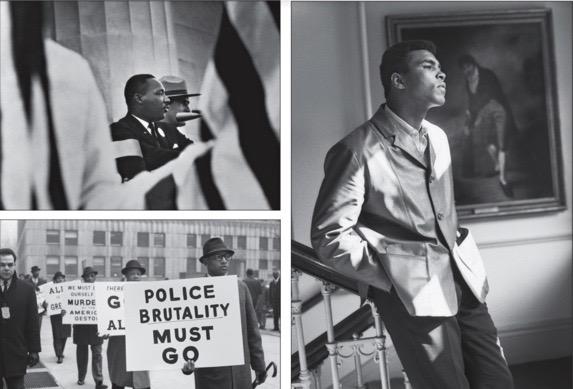“It’s the job of the artist to have your subject comfortable. And Gordon had that gift,” says Spike Lee in “A Choice of Weapons: Inspired by Gordon Parks,” John Maggio’s HBO documentary. Elsewhere in the film, Mr. Lee says, “That [weapon] wasn’t no six-shooter. When Gordon Parks had that camera in his hands, that was a bazooka.”
Mr. Lee is only one of many photographers, filmmakers, curators, and others, who extol Parks in the film. The filmmaker Ava DuVernay, speaking especially of African-Americans, said “Gordon Parks put a lens and a light on us for ourselves and allowed us to see the elegance of the lives we live.”
Michal Raz-Russo, a former curator at the Art Institute of Chicago and now programs director of the Gordon Parks Foundation, marvels at the range of his work, which includes films, books, poetry, and music as well as photography. “But it’s all tied together by his approach. He’s fully invested in every one of his subjects.”
“A Choice of Weapons” will be shown Friday at 6 p.m. at the Parrish Art Museum in Water Mill as the first of two programs dedicated to Parks in a collaboration between the museum and the Eastville Community Historical Society of Sag Harbor.
“Beyond the Lens: Capturing Culture and Conscience,” a panel discussion devoted to Parks’s achievements and influence, will be moderated by Georgette Grier-Key, the executive director and chief curator of the historical society, on Friday, Feb. 18, at 6.
Dr. Grier-Key will be joined by Donnamarie Barnes, the director of history and heritage at Sylvester Manor on Shelter Island as well as a photographer and photo editor, and by Steven John Irby, a Black photographer from New York City.
Parks was born into poverty and segregation in Kansas in 1912. When as a young man he saw images of migrant workers, taken by Farm Security Administration photographers, he bought a camera and taught himself how to use it.
In 1942 he won a Julius Rosenwald Fellowship, which awarded grants to African-American writers, educators, artists, and scholars. That led to a position with the photography section of the F.S.A. in Washington, and one of his most enduring images.
Early during his time there, Parks approached Ella Watson, a Black woman who was cleaning the agency's offices. She gave him access to her home and community over four months, where he saw crumbling houses, trash-filled neighborhoods, and other evidence of a divided city.
The culminating image of the series, “American Gothic,” shows Watson posed with a mop and a broom in front of an American flag. One of the most famous photographs Parks ever took, it not only expressed the contradictions of life in the United States and the solemn dignity of the working woman, but also reinterpreted Grant Wood’s iconic 1930 painting.
In 1948, Parks became the first African-American photographer hired by Life magazine. For his first story, he spent a week with Red Jackson, the most notorious gang leader in Harlem. Eight years later, he covered segregation in the South for Life, just one year after the murder of Emmett Till.
The film follows Parks through his long and celebrated career, including his photographs of Muhammad Ali, Malcolm X and the Nation of Islam, and poverty in Brazil. It also delves into his film career.
His semi-autobiographical film “The Learning Tree” (1969) was the first major studio film directed by an African-American. It was followed two years later by “Shaft,” a critical and box office success that launched a series of sequels and garnered an Oscar for Isaac Hayes’s theme song.
However, when Blacksploitation cinema ran its course, Parks could not get hired as a director. Even though, as “A Choice of Weapons” points out, he opened the door, he didn’t fit in in overwhelmingly white Hollywood. Nonetheless, Ms. DuVernay said, “He lifted us as he climbed.”
The film includes archival footage of interviews with Parks as well as commentary by such notables as Ms. DuVernay, Kareem Abdul Jabbar, Anderson Cooper, and others. Just as important are the insights of younger photographers, among them Devin Allen, LaToya Ruby Frazier, and Jamel Shabazz, all of whom express their indebtedness to Parks.
The two programs emerged from what Dr. Grier-Key called her “great working relationship with the Parrish over the years.” When she and Corinne Erni, the museum’s senior curator, were discussing what to do in conjunction with Black History Month, Dr. Grier-Key suggested the just-released “A Choice of Weapons,” and the idea for the panel discussion followed.
A professor, preservationist, historian, and curator, Dr. Grier-Key said she originally wanted to be a photographer herself. She studied photography in high school and eventually worked for Lifetouch, taking photographs of students.
“Parks’s images absolutely influenced me,” she said. “I think they really made me look at photography as an art form. His subject matter made me look at things differently.”
She noted that younger photographers, like Mr. Irby, inhabit different worlds but look to Parks and take from him. “Because of him, we’re possible. It’s like when we talk about James Baldwin, it sounds and feels like he is alive today and talking about today. How much has the subject matter changed?”
Ms. Barnes earned a degree in fine art photography and worked for 30 years as a photo editor for Essence and People magazines, all the while continuing to take her own photographs.
“I think any Black photographer has to say that they owe a great debt to Gordon Parks. I became aware of him at a young age, mostly because Life magazine was always in our home. His images, his style, his sense of storytelling, his use of black and white were so powerful.”
For a period, Ms. Barnes worked primarily as a street photographer, mostly in Harlem. “That was a big part of my growing as a photographer, to be able to be on the street and create images of what I saw, the culture and the place and the people at that time.”
Tomorrow’s screening is free. In-person tickets to the panel discussion are $12, $9 for senior citizens, free for members and students. Advance registration has been recommended. The panel will also be livestreamed free of charge.




